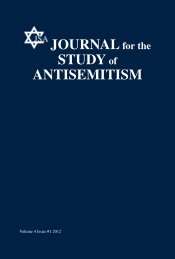Journal for the Study of Antisemitism
Journal for the Study of Antisemitism
Journal for the Study of Antisemitism
Create successful ePaper yourself
Turn your PDF publications into a flip-book with our unique Google optimized e-Paper software.
194 JOURNAL FOR THE STUDY OF ANTISEMITISM [ VOL. 1:187<br />
have to keep <strong>the</strong> Christian Sabbath as well. Thus <strong>the</strong> poor fool had to<br />
spend two days and two nights stuck in a privy.<br />
Key Antisemitic Legends<br />
Antisemitic legends are not random. They have in common <strong>the</strong> idea <strong>of</strong><br />
Jew as underminer or betrayer. In that sense, <strong>the</strong> actions <strong>of</strong> “The Jew” are<br />
Judas-like, directly implicating Jews in <strong>the</strong> deicide. The notions <strong>of</strong> <strong>the</strong> Wandering<br />
Jew, Blood Libel, Host Desecration, and <strong>the</strong> Jew as money-lender<br />
and devil have direct Christian linkage. The Jew as conspiring <strong>for</strong> planetary<br />
takeover appears to have evolved in <strong>the</strong> nineteenth century soon after Jewish<br />
emancipation and citizenship were secured throughout Europe.<br />
1. Eternal Wanderers (Eternally damned <strong>for</strong> taunting Jesus on <strong>the</strong> road<br />
to Calvary)<br />
The Wandering Jew is a figure from Re<strong>for</strong>mation Christian folklore<br />
(Roditi 1979) who became a legend in <strong>the</strong> thirteenth century throughout<br />
Europe. The original version concerns a Jew who taunted Jesus on <strong>the</strong> way<br />
to <strong>the</strong> Crucifixion (or refused to give him a drink <strong>of</strong> water). As a result, <strong>the</strong><br />
Jews were cursed to roam <strong>the</strong> earth until <strong>the</strong> Second Coming. Sometimes<br />
The Jew is envisioned as a shoemaker or trader, with sightings having been<br />
claimed up through <strong>the</strong> twentieth century. “The Eternal Jew on <strong>the</strong> Matterhorn”<br />
demonstrates a negative portrayal.<br />
Mount Matter beneath <strong>the</strong> Matterhorn in Valais is a high glacier from<br />
which <strong>the</strong> Vispa River flows. According to popular legend, an imposing<br />
city existed <strong>the</strong>re ages ago. The Jew came <strong>the</strong>re once and said: “When I<br />
pass this way a second time <strong>the</strong>re will be nothing but trees and rocks<br />
where you now see houses and streets. And when my path leads me here<br />
a third time, <strong>the</strong>re will be nothing but snow and ice.” And now nothing<br />
can be seen <strong>the</strong>re but snow and ice.<br />
In <strong>the</strong> most famous and first recognized version (in 1144), <strong>the</strong> wandering<br />
Jew is thought to bring good <strong>for</strong>tune.<br />
The Lost Jew<br />
Once in my life I saw <strong>the</strong> lost Jew. One afternoon I was home alone when<br />
a youthful Jewish man entered my house. He wanted nei<strong>the</strong>r to buy nor to<br />
sell anything, but with his Jewish accent asked me <strong>for</strong> a bite <strong>of</strong> bread. I<br />
said to him, “You won’t like our coarse peasant bread,” to which he<br />
replied, “I will like it, if <strong>the</strong> lady would just give me some.” I <strong>the</strong>n asked<br />
him, “Have you come a long way?” He answered, “My way is long! I














